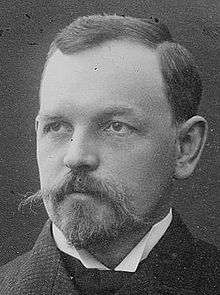Otto Nordenskjöld

Nils Otto Gustaf Nordenskjöld (December 6, 1869 – June 2, 1928) was a Finnish and Swedish geologist, geographer, and polar explorer.
Biography
Nordenskjöld was born in Hässelby in Småland in eastern Sweden, in a Finland Swedish family that included his maternal uncle, polar explorer Adolf Erik Nordenskiöld, and cousin Gustaf Nordenskiöld. His father and mother were cousins, but his father's family name was "Nordenskjöld", while his mother's family name was spelled "Nordenskiöld".
He studied at Uppsala University, obtaining a doctorate in geology in 1894,[1] and later became a lecturer and then associate professor in the university's geology department.[2]
Otto Nordenskjöld led mineralogical expeditions to Patagonia in the 1890s, and to Alaska and the Klondike area in 1898.
He led the 1901-1904 Swedish Antarctic Expedition, aboard the ship Antarctic. The expedition visited the Falkland Islands before the ship, commanded by seasoned Antarctic sailor Carl Anton Larsen, dropped Nordenskjöld's party off at Snow Hill Island, a small island off the coast of the Antarctic Peninsula. Nordenskiöld overwintered at Snow Hill Island, while Antarctic returned to the Falklands. The following summer Larsen brought her south, intending to retrieve the Nordenskiöld party, but she became trapped in ice which eventually crushed her hull, forcing Larsen and his crew to overwinter in a hastily constructed shelter on Paulet Island. Larsen and Nordenskjöld finally rendezvoused at their fall-back rescue hut at Hope Bay in late 1903, where they were picked up by the Argentine Navy corvette ARA Uruguay (commanded by Julián Irízar), which had been dispatched when Antarctic had failed to make her appointed return to South America the previous year. Despite its end and the great hardships endured, the expedition was considered a scientific success, with the parties having explored much of the eastern coast of Graham Land, including Cape Longing, James Ross Island, the Joinville Island group, and the Palmer Archipelago. The expedition, which also recovered valuable geological samples and samples of marine animals, earned Nordenskjöld lasting fame at home, but its huge cost left him greatly in debt.
In 1905 he was appointed professor of geography (with commercial geography) and ethnography at University of Gothenburg.[3]
Nordenskjöld later explored Greenland in 1909 and returned to South America to explore Chile and Peru in the early 1920s (many samples from this expedition are now displayed at the Natural History Museum in Lima). He was killed in a traffic accident at the age of 59, when he was hit by a bus, in Gothenburg where he was also buried.
Nordenskjöld also studied the effects of winter on alpine climate, and developed a formula for identifying the boundaries of the Arctic region based on the temperatures in the warmest and coldest months of the year.[4]

Legacy
A number of geographical features have been named after Otto Nordenskiöld, including:
- Nordenskjöld Lake, an alpine lake in Chile's Torres del Paine National Park
- Nordenskjöld Coast, a section of the coast of the east side of the Antarctic Peninsula
- Nordenskjöld Basin, an undersea basin
- Nordenskjöld Ice Tongue, a glacial ice tongue extending over the Ross Sea
- Nordenskjöld Glacier, a glacier on South Georgia
- Nordenskjöld Outcrops, rocky outcrops on the Antarctic Peninsula
- Nordenskjöld Peak, a mountain on South Georgia
Publications
- Antarctica: Or, Two years amongst the ice of the South Pole ISBN 0-208-01642-2
- S A Duse (1905), Bland pingvinar ock sälar, minnen från Svenska sydpolarexpeditionen 1901-03.
References
- ↑ Project Runeberg biography
- ↑ south-pole.com biography
- ↑ "Major Events in the history of the department" Department of Human and Economic Geography, Gothenburg University, retrieved April 28, 2006
- ↑ Seppälä, Matti (2004). Wind as a Geomorphic Agent in Cold Climates. Cambridge University Press. ISBN 0521564069. Retrieved 2012-08-15.
External links
- south-pole.com's article on Nordenskjöld's antarctic expedition
- (Swedish) Project Runeberg biography, including extensive bibliography
- Photographs of the Nordenskiöld expedition to the Antarctic Peninsula
- ARA Uruguay rescue - see section APETITOS ANTÁRTICOS (in Spanish)
-
 "Nordenskiöld, Nils Otto". Encyclopedia Americana. 1920.
"Nordenskiöld, Nils Otto". Encyclopedia Americana. 1920.
